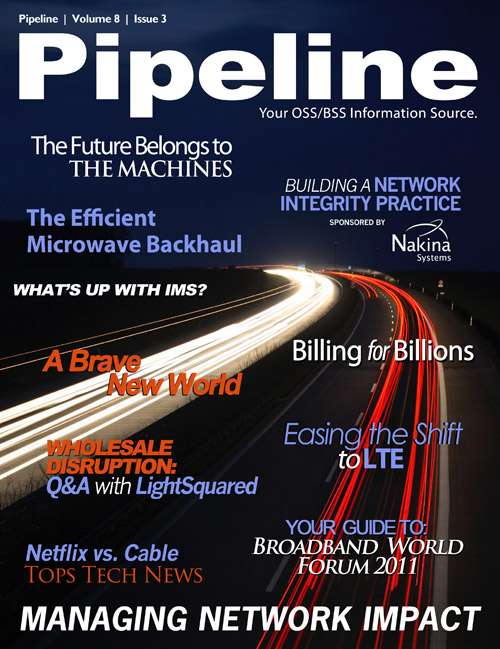Netflix strategy is, “ to consistently improve the quality of our service and stay two steps ahead, so
that consumers will continue to enjoy Netflix,” but one has to wonder how the company can offer such
quality improvements without owning the network hardware over which they stream their content.
How can Netflix control jitter, latency, and packet loss? Pipeline asked Netflix these questions, but as
of press time, they went unanswered.
Netflix singled out DishOnline as a potential competitor, and several days later Joe Clayton, CEO and
President of Dish Network, responded to the challenge in the LA Times. “Everybody's enamored with
Netflix. Who's to say we can't do the same thing? We have access to the studios, we have access to
huge movie libraries.” Clayton told the Times. It looks like Dish's purchase of Blockbuster and recent
spectrum spending spree are all part of a plan to battle Netflix and become a competitive player in
the wireless game. "We are putting together the building blocks to be able to provide a whole suite of services to the customer," continued Clayton. "Wireless voice, broadband, video, mobile … we're
going to have the capability to do all of the above."
Dish Network turning into a rival for AT&T or Comcast may be a stretch; the bigger question is can
Netflix do battle with the telcos and emerge victorious?
Analyst Richard MacDonald thinks they have a strong chance. In a recent article for investor analysis
website SeekingAlpha.com, MacDonald elaborated on the analysis he performed for his boutique
research firm:
“We believe Netflix's advantageous position vis a vis the consumer is, in general, the strongest business model we have studied in thirty years, save basic cable. Certainly it is more robust than Blockbuster, and more robust than Showtime (owned by CBS, but less than a 10% contributor) and probably HBO (owned by Time Warner and a substantially larger business). These businesses are outdated packaging models. About the only way they can compete on a level playing field is for the cable operator to waive the basic cable purchase requirement, and no cable operator is going to do that.”Restructuring and Rightsizing
Cisco and RIM tightened their belts this month, as both companies undertook restructuring efforts that included significant staff reductions. Cisco cut 9% of its workforce (6,500 employees) to shave a cool $1 billion of expenses, and RIM reduced its workforce by 11% (2,000 employees). On Wall Street, investors responded positively to the news from RIM, but the cuts were not enough to keep Cisco stock from continuing its downward trajectory.
RIM has just overhauled and relaunched its Blackberry line and made deals with 225 wireless operators, but a recent survey says nearly half of RIM and Android users will switch to iPhone which may mean it's too little too late for the beleaguered third-place mobile platform.
Beyond staff reductions, Verizon and RIM underwent executive restructuring this month as well. Longtime Verizon CEO Ivan Seidenberg, who has lead the company since 2000, stepped down and COO Lowell McAdam has filled the vacancy. For its part, RIM announced it will be shuffling the executive ranks, and COO Don Morrison left the company.





